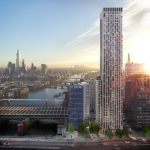CPA Board member and Partner at Newmark Jeremy Randall discusses the City of London Corporation’s approval of its City Plan 2040.
The Planning and Transportation Committee considered the draft City Plan 2040 on Wednesday (31.01.), with Members voting (18 in favour with 1 abstention) to progress the Plan to Regulation 19 pre-submission consultation.
The City’s earliest consultation on the issues and options for the new City Plan took place some eight years ago, reaching Regulation 19 stage for the first time back in 2021, when Members withdrew the Plan in order to develop a more robust evidence base to shape future growth in the Square Mile following the COVID-19 pandemic.
The evidence base developed over the last 18 months is extensive, incorporating 3D spatial modelling, detailed office market analysis and thematic studies to support a new cultural planning framework. The revised draft Plan has also been updated to reflect the London Plan 2021, recent changes to the National Planning Policy Framework and informal engagement with key stakeholders.
Presenting the new Plan, officers invited Members to reflect upon six key themes:
- Economic Growth
- Sustainable Development
- Housing and Residential Areas
- Tall Buildings, Views and Heritage
- Inclusion, Accessibility and Health
- Destination City
Economic Growth
The draft Plan continues the City’s long-standing approach of supporting economic and employment growth through the delivery of additional office floorspace, whilst also resisting the loss of existing offices in many instances. Underpinned by the well-publicised report of Arup/Knight Frank, the draft Plan seeks to deliver a minimum of 1.2 million sq m of new office floorspace over the Plan period to meet anticipated demand. In response to questions from Members, officers noted that their delivery target for office floorspace had increased whilst those in neighbouring authorities had decreased. Vacancy rates in the City are currently around 10% as a whole, however, officers acknowledged the differences between Grade A ‘best in class’ and Grade B floorspace. Overall, it was noted that the City is generally performing well against comparable international benchmarks.
The draft Plan takes a more flexible approach to retail and related uses, promoting a greater diversity of active frontages across the City and within the Principal Shopping Centres. Although the draft Plan still envisages strong demand from retail over the Plan period from a growing workforce and increased visitor footfall, the current Retail Links policy is not taken forward in the draft Plan.
The importance of the City Cluster area to provide significant office floorspace is outlined. The draft Plan maintains specific polices relating to The Temples, the Thames Policy Area and the Key Areas of Change. Largely the Key Areas of Change promote measures and spatial requirements to make the Areas more welcoming and vibrant, including through the provision of new and enhanced public realm, transforming the built environment, enhancing their heritage and cultural assets, and encouraging greater diversity of retail, leisure and culture activities.
Sustainable Development
A key emphasis of the design policies is a ‘retrofit first’ approach, requiring all major development to undertake options appraisal to identify the most sustainable and suitable approach for a site, as per the City Carbon Options Guidance PAN. Officers at Committee made very clear that this is not a retrofit only policy. It was also set out that there may be a greater case for demolition where there is potential significant uplift in floorspace to deliver against growth targets. This draft Plan is one of the first in the Country to take this approach and presents a significant change in policy direction (albeit promoted through the 2023 PAN). The policy also sets high standards for environmental performance of new buildings, approaches to mitigate climate impacts, and design that is informed by circular economy approaches.
A new ‘retrofit fast track’ has also been introduced – this allows a route to convert existing office buildings to a hotel, education or cultural use provided that the office is not strategically important and that it has been marketed as an office. This seeks to strikes a balance between seeking to promote investment in existing offices, incentivising retention of buildings where a change of use is being pursued, and recognising the challenges some grade B offices face in meeting market demand (particularly around the periphery of the Square Mile).
Design policy sets out a range of requirements covering issues from sustainable design, form and layout, experience of spaces, and the quality and character of buildings. Policy maintains the requirements to ensure development is of an exemplar standard of design, aesthetics and architectural detail; that development helps to enhance the City’s public realm, and it encourages roof terraces as well as cultural space where suitable, and requires a broad range of elevated public spaces in tall buildings and major development in accordance with the Destination City policies.
Climate resilience is also promoted with draft policy seeking to, amongst other things, minimise the urban heat island effect, the risk of flooding, implement sustainable drainage systems, and reduce and manage the City’s waste in sustainable ways.
A new policy is introduced that seeks to enhance the City’s biodiversity through new development; the new policy builds on the recently introduced national approach (Biodiversity Net Gain) while tailoring it to the City’s circumstances. The draft Plan continues to strongly support urban greening.
The City’s Transport Strategy informs the draft transport policies. Policy seeks to prioritise people walking and wheeling while facilitating the servicing of the Square Mile in sustainable ways, including through consolidation.
Housing
Housing policy broadly maintains the status quo. The City did undertake a ‘call for sites’ in 2022, but the exercise yielded limited developer interest for housing development in the Square Mile. Given the City’s success of delivery through ‘windfall sites’, i.e. unidentified sites, over the longer term, the draft City Plan continues this approach while providing greater certainty over the areas that would be suitable for new housing by identifying them clearly on a map. In debate Members specifically raised concerns about pepper-potting residential through the Square Mile but emphasised the importance of residential amenity particularly in respect of daylight and sunlight. Officers made clear that the City have delivered above their housing target of 114 per annum, noting that 174 dwellings had been delivered in the previous reporting period.
Tall Buildings, views and heritage
The draft Plan places a strong emphasis on the importance of the City’s heritage, and now reflects sophisticated townscape modelling around the LVMF strategic views as well as key landmarks, the latter including St Paul’s Cathedral, the Monument, the Tower of London World Heritage Site and Bevis Marks Synagogue. The proposed definition of the immediate setting of the Grade I listed Synagogue attracted particular attention in debate, drawing upon the Synagogue’s recent representations and the designation of the Creechurch Conservation Area. This lively debate now looks set to extend into the formal regulation 19 consultation process and is worth following closely.
The City’s three-dimensional spatial modelling has also informed a more comprehensive approach to the future development of tall buildings in the Square Mile, so responding to previous concerns around non-conformity raised by the Mayor of London. The Plan now sets out how tall buildings will be consolidated into two defined tall building areas, forming the City Cluster and Fleet Valley Cluster. The importance of considering both local heritage assets and other environmental factors is emphasised, alongside the need for exemplar architectural quality and sustainable and accessible building design.
Inclusion, Accessibility and Health
The draft Plan seeks to create a more inclusive, healthier and safer City for everyone. These aims and objectives are outlined in Chapter 3, under the title “Health, Inclusion and Safety”. Inclusion is threaded through many aspects of the City Plan. The draft Plan seeks to create a healthier City by promoting buildings designed with health in mind; improving air quality; and creating and protecting quieter spaces in the City. This chapter also seeks to promote sports, recreation and play in the City and in particular encourage new facilities in appropriate locations, reflecting the aims of the City’s new Sports Strategy.
Destination City
One of the biggest changes to the draft City Plan over the previous iteration is the introduction of ‘Destination City’ policies, recognising a “crucial role” for culture and visitors in creating a more vibrant and inclusive Square Mile. Policy on this topic is woven through the draft Plan and seeks the development of a wide range of cultural, leisure and recreational facilities across the City, all informed by a Culture Planning Framework. The draft Plan requires the provision of arts, culture or leisure facilities in major developments, commensurate with their size. To support the City’s longer-term cultural vision, the draft Plan also takes a more positive approach towards the provision of new visitor accommodation.
Next Steps
The draft City Plan 2040 will be presented to the Policy and Resources Committee on 22 February, and should then be considered by the Court of Common Council on 7 March. If endorsed, we can expect formal Regulation 19 public consultation to commence shortly thereafter, running for a minimum of six weeks (in accordance with the Statement of Community Involvement). The City expects to submit the draft Plan to the Secretary of State in August, with Examination in Public in November/December 2024.
Further reading:
Blog: The City’s Sustainability SPD – Balancing net zero and economic competitiveness by Peter Twemlow
Blog: Bringing Café Culture to the City by Gareth Roberts
Blog: Tall buildings, heritage and the future of the office by Jeremy Randall


